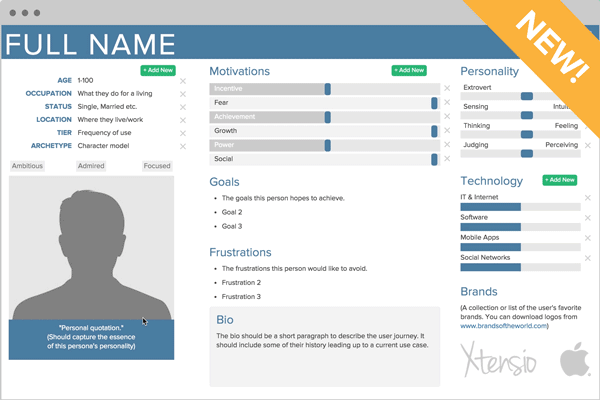BLOG
FAKE CROW'S BLOG
Iterating Towards Product Market Fit

Building a product is hard. Transforming your product from an MVP into a full-fledge, well-oiled machine is really hard. We know. We’ve been there. At this early stage, we’ve witnessed startups succeed and also fail. At Fake Crow, we consult and design for startups. We decided to tackle the challenge on our own: we built and launched our own platform.
Xtensio is a SaaS product we created in-house. Our experience developing and driving Xtensio towards its product market fit underscored just how critical the time between MVP completion and public launch is for fresh products. The decisions made during this period can make or break a business.
 The first “Coming Soon Page” we published for Xtensio before coding a single piece of the product.
The first “Coming Soon Page” we published for Xtensio before coding a single piece of the product.
Here’s what we did following Xtensio’s MVP creation through its public release. If you’re looking to get a product up and running, and continually progressing towards product market fit, our process might be useful for you.
Launch your product in private beta as soon as possible. Duh?
This advice is a cliche by now, but it’s amazing how little it’s practiced. Once your MVP is ready, not perfect, but ready to test, onboard a private and select audience to try it out. Do it fast. This initial testing will provide crucial insight into the most basic and vital questions such as: Are people able to use the product? Do they like it? Do they need it? Does it deliver on its promise? Is it accomplishing what you designed it to do?
 The next version of the Beta Sign-Up page we launched while building the MVP.
The next version of the Beta Sign-Up page we launched while building the MVP.
Xtensio began as a one-pager builder, an easy to use, flexible template for startups to present business ideas. Before launching Xtensio’s MVP, we gathered about 600 beta signups through our Beta Sign-Up page. We kept the product private and the test group reasonably sized so we could monitor how users interacted with Xtensio, then make the necessary changes before going public.
Take a breath. Watch what happens. Don’t expect fireworks.
Observing the results of private beta testing will shed light on what’s working, and even better, what’s not. It will point you to what needs fixing and to what you need to do next. Great!
Xtensio’s private Beta Sign-Up page had a conversion rate of 20%. This percentage was fine, however, users were not returning to the site. ⅓ of those who signed up never returned. This was a problem.
Chances are there is a disconnect between your product and its positioning.
If your early test results are not making you feel like a billion bucks, here’s what might be going on:
1. No one’s interested in what you’re offering. You could have an awesome Unique Value Proposition and a killer product, but if users don’t have a place for your product in their daily lives, your business will be irrelevant.
2. Your offer is attractive, but the product doesn’t deliver on its promise. Consumers’ expectations are not met, and so they turn away.
3. Your product is strong, but not resonating with consumers. If you’re doing a bad job telling your product’s story, that is, explaining its core value, what it does and how it works, you’ll lose consumer interest.
Let users reveal your weakest spots.
Understanding user behavior is no picnic. It takes work and the right set of tools.
 Xtensio’s user sessions during the Private Beta period. Right before the peak at Public Launch.
Xtensio’s user sessions during the Private Beta period. Right before the peak at Public Launch.
1. Measure how users are interacting with your site. We used (and still do!) a mix of analytics programs with Xtensio. But we started off with the most basic tool: Google Analytics. The program gave us information about who our users are in general, how they behaved on the site / app and how they learned of Xtensio to begin with. We also built a basic internal dashboard to see app specific data and dive deeper into the details of each interaction.
2. Do this early! Your user testing systems should be implemented as soon as possible to to ensure you’re able to monitor as much of your private Beta launch as you can. Don’t lose valuable data just because you didn’t take five minutes to insert Google Analytics code into your app.
3. Actually talk to users. You should experience first-hand, users’ reaction to your product. We invited users to test out Xtensio and observed as they were impressed, then confused. We then took time to listen to their honest feedback.
4. Don’t go overboard. As important as building systems to measure user activity is, spending too much time developing analytics systems puts you at risk of neglecting your product itself and the improvements it requires. The trick is to prioritize analytics that give you the most insight into problems with low cost, relatively quick remedies.
The combination of data analytics and direct communication with users pointed to three reasons why users were not returning to Xtensio:
1. Consumers didn’t understand why they should use product.
2. They didn’t realize they could make multiple “folios”.
3. The Startup One-Pager wasn’t something they were ready to complete. Either they had nothing to present to investors, or they didn’t have the information needed to fill in the document.
Our problem (thankfully) was a combination of the last two. Users were signing up for the premise, “visualize your company profile in 15 minutes”, but not returning to the site to do more work. They weren’t quite prepared to fill out the contents of a One-Pager. Also, Xtensio wasn’t in its most elegant shape to function as a sturdy presentation tool. Yet the ease and simplicity of the product was attractive to the users. There was something useful about Xtensio. But users didn’t quite understand what they could use it for.
The Next Iteration
Here’s what not to do after hearing a whole bunch of feedback that can easily throw you off your game. Don’t attempt a major product overhaul that takes weeks of time and loads of money to engineer. Also don’t try to ignore current problems and run an extravagant marketing campaign to sell a broken product. Instead:
1. Use what you’ve got. Leverage what is working, and for what isn’t, opt for low-cost, easy to implement solutions. We had already created an interactive tool with flexible modules, drag-and-drop and easy editing features. Aside from a few natural bugs, overall usability wasn’t a problem. To give users reasons to return to Xtensio, we created five new templates — The User Persona, The Lean Canvas, The Fundraising Summary, The SWOT Analysis, and The Blank Slate. We leveraged a proven concept, the User Persona template because it had been downloaded thousands of times off the Fake Crow website.
Fake Crow’s User Persona Template had already been downloaded thousands of times from our website. We married this proven concept with Xtensio’s interactive functionalities.
2. Protect your fans. If your product is clicking with a certain group of people, focus on maintaining this group’s support. We shared Xtensio.com on Reddit with the headline: “6 must-have startup tools, for free.” The post received about 100 upvotes and brought about 2000 visitors to our website in a matter of hours. We also looked into trending keywords on search engines. “Startup tools,” “help startup,” and others were top searches. It was clear — startups needed help. They became our target audience. The group we wanted to protect, serve, and grow.
3. Reposition. We changed our positioning from “Show investors what you’re all about” to “A toolbox for your startup.” This shifted Xtensio’s key value proposition away from strictly external sharing and towards internal brainstorming and strategizing.
4. Continue CRM. Aside from an automated welcome message sent to all new users, we crafted personalized messages to specific individuals. We drafted emails to users who were “slipping away,” that is, those who signed up two weeks prior, but only had one session in app.xtensio.com. We also altered the tone of our messages. From welcome notes (automated via Intercom) to placeholder text in the templates/tools, we made all text clear, friendly, and as helpful as possible.
Bingo.
 Where we’re at today: averaging a 25% conversion on our new home page and attracting new users every day.
Where we’re at today: averaging a 25% conversion on our new home page and attracting new users every day.
Xtensio opened for public beta on April 29. Within a few hours, traffic increased on the site. Each time a new user signed-up, Intercom pushed an alert, accompanied by a “ding,” to our Slack channel. The bell began ringing frequently in the studio. After a few additional Reddit posts (by others) and Twitter traffic, Xtensio saw another five thousand new users within a month.
Key things to remember when developing your product:
1. Launch fast. As soon as you have an MVP (assuming it is minimal and viable), test it with a private group of users.
2. Invest reasonable time measuring and tracking user activity, so you know what’s working and what’s not.
3. Leverage your strengths. Don’t waste money starting from scratch. Take what’s already functioning and iterate towards a next version of the product. (Unless you were dead wrong about every assumption made. In this case…head back to the drawing board.)
4. Make a small number of users happy. If you have an audience that is pleased with your product, do everything you can to maintain their support. This is the core group you’ll want to grow once you’ve found a market fit. And–
5. Don’t try to grow until you’ve found a market fit. Until you’ve gone through the steps above, don’t add a ton of new features and services. Make sure what you have is working, selling, and upholding its promise before you take your product to the next level.
Overwhelmed? Not sure where to begin? We’re here to help.
Xtensio was created to help first time entrepreneurs overcome business obstacles. Our tools help early-stage companies make smart decisions. If you’re looking for guidance, check out Fake Crow, a startup friendly creative agency in LA. We’re a team of hackers, problem solvers, and creative thinkers working tirelessly with companies large and small to carve out their niche in the online marketplace and optimize product design and UX. Learn about our services at: www.fakecrow.com
Shoot us a message. We’d be thrilled to hear from you.





